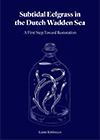PhD defence Katrin Rehlmeyer
| When: | Tu 01-07-2025 at 14:30 |
| Where: | Academy Building & online |
Katrin Rehlmeyer (MarBio/ConsEco)
Promotores: Prof. L.L. Govers, Prof. T. van der Heide; copromotor: Dr O. Franken

Subtidal eelgrass in the Dutch Wadden Sea
A first step toward restoration
Seagrass meadows are valuable underwater ecosystems that support marine life, improve water quality, store carbon, and protect coastlines. In the past, vast meadows of subtidal eelgrass (Zostera marina), which grows permanently underwater, once covered 75–150 km² of the Dutch Wadden Sea. These meadows disappeared in the 1930s due to a disease outbreak and major human intervention, particularly the construction of the 32-km-long Afsluitdijk. Natural recovery has not occurred and is highly unlikely because there are no nearby sources of eelgrass seeds or plants. Active restoration is therefore necessary to bring back this important habitat-forming species. This thesis explores the potential for restoring subtidal eelgrass in the Wadden Sea through the integration of computer models, laboratory experiments, and field studies. We developed a habitat suitability map and identified small areas where conditions may still support eelgrass. The biggest limitations for eelgrass growth are poor light conditions and wave action. Since the loss of eelgrass almost a century ago, the salinity conditions in the Wadden Sea have changed. Our experiments, however, showed that eelgrass can tolerate these fluctuations. When seagrass meadows are lost, their functions of sediment stabilization and reduction of hydrodynamics are also lost. In the field, artificial root structures helped stabilize sediment and improved short-term eelgrass survival. However, underwater barriers designed to reduce hydrodynamic stress had mixed results and worsened conditions through erosion. Local factors, including algae growth, also strongly influenced success. Although reintroducing subtidal eelgrass in the Dutch Wadden Sea is challenging, this research marks the first step toward restoration. With targeted, science-based efforts, restoration may be achievable. The findings provide valuable insights for coastal restoration efforts worldwide.
